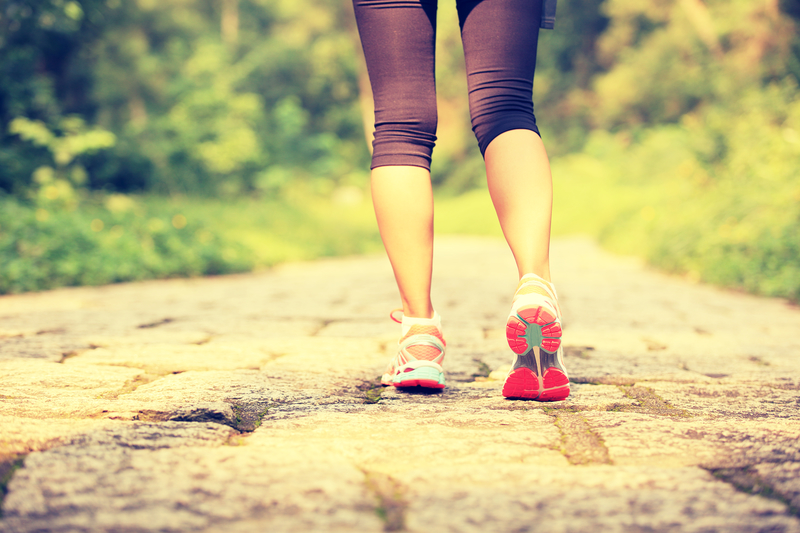7 Incredible Health Benefits of Walking Daily (so bust a move)

We’ve all heard the benefits of exercise. It’s the “fountain of youth,” right? With so many benefits, it’s hard to list them all in one article. Yet, when you hear “exercise,” what’s the first thing that comes to mind?
If you’re like most people, it’s probably…hitting the gym, lifting weights, running, jogging, HIIT, Tabata training, going on a bike ride, taking an exercise class, or doing Crossfit. Or perhaps you thought about specific exercises, like squats, pushups, sit ups, or pullups.
But what about walking? That’s just what you do to get from point A to point B, right? It’s not really exercise; it’s more of a leisure-time activity, right? It’s not like you get out of breath or break a sweat (unless it’s a steep hill or a hot day), so how much good can walking really be as a form of exercise? And are there really health benefits of walking daily?
Well, my friend, you may just want to lace up your walking shoes and hit the pavement, trail, or path after you read through this list of benefits you get from doing something you’ve been doing since, well, you learned how to walk.
7 Health Benefits of Walking Daily
Did you know that an estimated 40% of adults don’t walk at all, and it’s getting worse as more of us spend time tied to technology? Yet walking is an activity that’s accessible to nearly everyone, and it’s incredibly affordable, enjoyable, and downright easy for most of us.
Here’s a short list of just a handful of the many health benefits of walking daily:
- Helps maintain a healthy weight. Walking burns calories, and the faster and longer you walk, the more calories you’ll burn. In addition, walking can help increase muscle tone and strengthen the entire body, especially the legs and butt. It can also help improve balance and prevent falls. What’s more, taking a 30-minute brisk walk can improve insulin sensitivity, and regular walking can help you better manage blood sugar and reduce belly fat.
- Increases energy. By improving both circulation and increasing the supply of oxygen to cells throughout the entire body, walking helps increase energy levels. Give it a try after lunch or when you’re feeling an energy slump to see if it doesn’t give you a bit of a boost. Research shows that 30 minutes of aerobic activity, like taking a walk, can improve concentration, memory, reasoning, and planning.
- Increases creativity. Get this, in a 2014 study published in the Journal of Experimental Psychology, Learning, Memory, and Cognition, researchers found that walkers think more creatively than sitters during creative-thinking tests. In fact, walking increased creative thinking by 81% on one standard test for creativity and 23% for another. Need to solve a problem, create a solution, or spark the imagination? Grab a quick walk! And the brain health benefits of walking —and exercise in general— apply to children too. In other words, kids perform better in the classroom when they move more. And I keep hearing about schools taking away recess. What a shame.
- Reduces the risk of heart disease and stroke. In fact, research has indicated that walking can reduce the risk of cardiovascular disease by up to 27%. How? By promoting healthy blood pressure, improving circulation, reducing LDL (“bad”) cholesterol, increasing HDL (“good”) cholesterol, and increasing how much blood the heart pumps with each beat (called “stroke volume”). The health benefits of walking don’t stop there. Walking also reduces the chances of developing type 2 diabetes, which increases one’s risk for heart disease and stroke. Again, by maintaining blood sugar levels and blood pressure in healthy ranges, walking supports overall health and reduces the chances of various chronic diseases.
- Supports a healthy mood. Fitness mogul Bill Phillips is often quoted as saying, “Food is the most widely abused anti-anxiety drug in America, and exercise is the most potent, yet underutilized anti-depressant.” It’s true, and simply moving can be good therapy to prevent and even relieve some symptoms of depression. Research has even shown that walking can help lessen feelings of anger and hostility. Plus, walking outdoors in the sunshine helps increase vitamin D levels and provides an escape from daily stresses. It’s a perfect way to breathe deeply and put problems into perspective.
- Builds bone density and joint health. Along those lines, walking may help prevent osteoporosis and osteoarthritis. Walking can also improve balance and coordination, which helps prevent falls and associated injuries, such as hip fractures. In addition, walking helps keep the joints mobile by increasing the lubricating fluid between bones.
- Preserves memory and brain function. This especially important and relevant as you get older. Believe it or not, regular physical activity, such as walking, has been shown to reduce the risk of dementia by up to 40%.
Surely with that list of the health benefits of walking daily, you’re likely ready lace up your sneakers—if you didn’t have them on already. While you can start out with just a few minutes at a slower pace, to really enjoy the benefits described above, you’ll want to gradually build up to at least 30 minutes of brisk walking a day. Then, continue to pick up the pace, increase your walking distance, and/or add some hills or stairs into your daily walk. The body is nothing if not adaptive, so keep challenging yourself to continue to improve and enjoy all the benefits walking has to offer.
What if you can’t manage a full 30-minute session? No worries! It can be just as effective to break up your walks into multiple sessions throughout the day. Ten minutes here, 15 minutes there. It all adds up.
Oh, and if you have a significant other, a friend, or even a dog, invite them to join you. It will give you a chance to connect—which has some additional awesome benefits.
Now, go take a walk!






